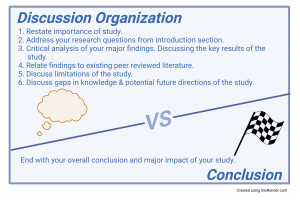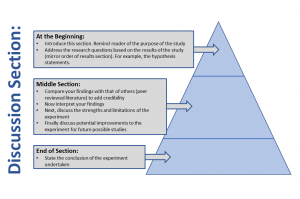5 The Discussion Section
5.1 Purpose of the Discussion Section
The Discussion section of a formal lab report is the subjective portion of the lab report where you critically analyze and interpret the experimental data. This is done in the context of the specific questions being addressed by the experiment and indicates the significance and meaning of the results to the reader. Here you indicate that you truly understand the experiment undertaken including the background information. You do this by considering the original question you addressed (as stated in the Introduction section of your report) and bringing forward any additional insights generated by the experimental findings that are supported by an additional review of the peer-reviewed literature. It is important to remember to distinguish possibilities from fact. Experiments do not prove anything! They simply support or fail to support hypotheses. The interpretation of data may not necessarily be correct and is subject to change when new information becomes available however, the experimental data (results) always remains credible even though the interpretation of it may change in the future.
5.2 Organization of the Discussion Section
The Discussion section is written in past tense and paragraph form. The topics discussed in this section should be organized similarly to the results section and key elements should be separated into distinct paragraphs (See Figure 6). It is often wise to write paragraphs and then in the editing process, reorganize the information so that it flows in a clear, logical order. Both Figures 6 and 7 provide you with a guideline on how to organize the Discussion section professionally.
When the lab unit includes questions to be addressed in the Discussion, the answers need to be integrated into the Discussion section logically, not simply answered in the order they were asked in the assignment guidelines you are given. We intentionally do not put those questions in order as we want you to learn to organize your paragraphs logically. The final paragraph of a Discussion Section is always the conclusion and should include a brief summary of the key findings of the experiment (e.g., supported hypothesis statement) along with how the findings are relevant to the field of study.
Figure 6
Lab report Discussion section organization

Figure 7
An Infographic on how to construct the Discussion section of a formal lab report

Every experiment that is properly executed tells us something even if it is not what you specifically intended to find out. Therefore, it is important to include an explanation of any unexpected results in the Discussion section. It is common for students to suggest that unexpected data was due to equipment failure or human error, but often there is a much more scientifically interesting explanation for experimental abnormalities. It is best practice to look for alternative scientific explanations other than faulty equipment and human error.
It is also best practice in a Discussion section to suggest ways to improve the experiment and what potential future experiments might expand on what you have learned in this subject area. The best location for this portion and the potential source(s) of error is often just before the concluding paragraph in the Discussion section.
